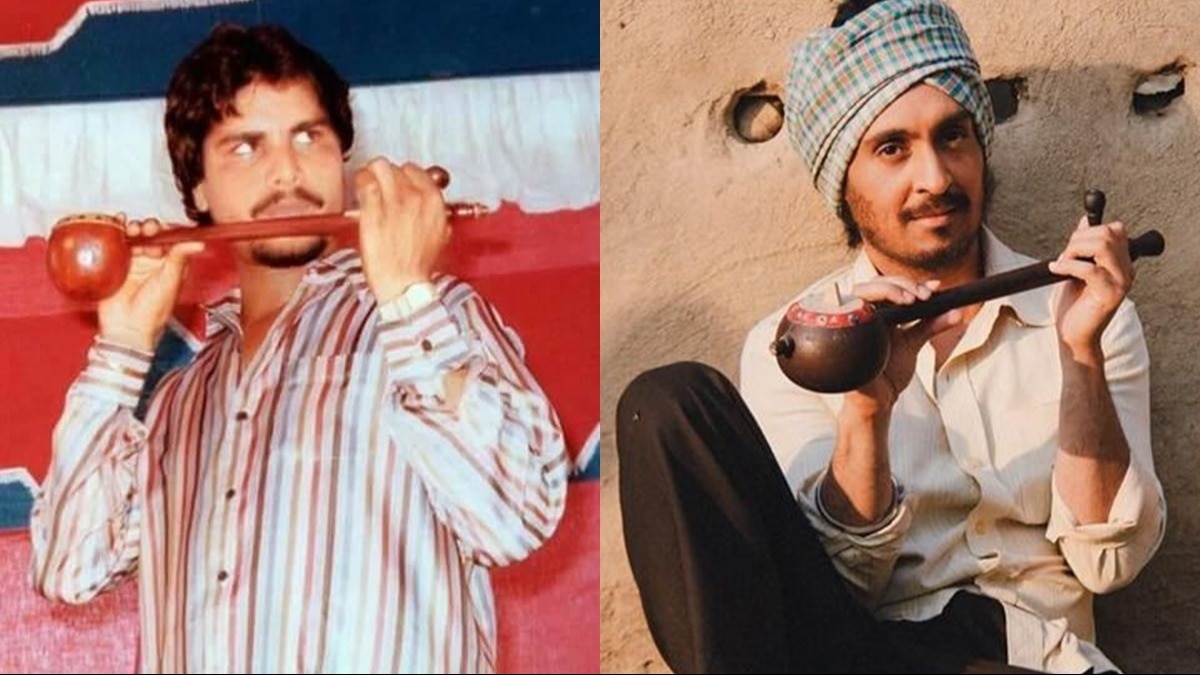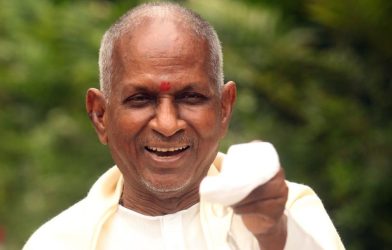In the history of Punjabi music, one name reigns supreme – Amar Singh Chamkila. Though his melodies stirred the souls of millions, his music was considered low-brow because of the double-entendre lyrics.
It wouldn’t be wrong to say that Chamkila’s illustrious career holds poignant resonance in the lyrics of Diljit Dosanjh’s song ‘Born to Shine’. Chamkila was born to shine. How else do you describe his journey from a Dalit labourer to a legendary singer?
Diljit Dosanjh, unquestionably the biggest Punjabi celebrity right now, plays Chamkila in director Imtiaz Ali’s upcoming film, Amar Singh Chamkila. The film promises to shed light on the enigmatic life of the popular singer who met a tragic end as he was shot dead at the age of 27.
Amar Singh Chamkila also stars Parineeti Chopra and will stream on Netflix from April 12.
Before the film’s release, we deep dive into the life and legacy of Chamkila, the folk icon who shaped the Punjabi music industry and whose influence transcends generations.
THE EARLY LIFE OF AMAR SINGH CHAMKILA
Born on July 21, 1960, in the poor Dalit Ramdasia family of Dugri village near Ludhiana, Chamkila was named Dhani Ram.
He worked as a labourer in textile factories in Ludhiana but had a passion for music. His passion drove him to join drama groups where he honed his singing skills and also learnt to play the harmonium and the tumbu (a single-string instrument).
At 18, Dhani approached Surinder Shinda, a legendary folk singer from Punjab. Impressed with his raw voice, Shinda took him under his wings. Soon he established his place in Shinda’s troupe as a prolific songwriter. He also collaborated with luminaries like Mohammad Sadiq and Kuldeep Manak.
CHAMKILA RECORDS FIRST ALBUM IN GLITTERY START
In 1979, Dhani decided to go it alone and recorded his first solo album with folk singer Surinder Sonia. The album ‘Takue Te Takua’, comprising eight songs, was released in 1979, making Dhani and Sonia overnight stars in Punjab.
It was the success of the album which made Dhani adopt the stage name Amar Singh Chamkila, and there was no looking back from there. Chamkila translates to glittery in English.
Soon, the duo of Chamkila and Sonia released another album titled Baapu Saada Gum Ho Gaya, increasing the demand of both singers for stage shows and performances at wedding ceremonies. However, Sonia and Chamkila fell apart due to the gap in their earnings. Chamkila wanted pay parity.
Then, Chamkila briefly collaborated with singer Usha Kiran, before beginning his successful partnership with singer Amarjot Kaur, who later became his wife.
Their debut LP record, Bhul Gayi Main Ghund Kadna, featured the song, Pahile Lalkare Naal Main Darr Gayi, which catapulted them to superstardom.
Chamkila and Amarjot released three devotional LPs after 1985 — Baba Tera Nankana, Talwar Main Kalgidhar Di Haan and Naam Jap Le. It is said that the two had an almost “Brechtian style of performance”.
Filmmaker Kabir Singh Chowdhry, who made a film on Chamkila titled Mehsampur once told Scroll, “They were very involved with each other on the stage – it was like they were having a conversation where she would say something and he would respond.
CHAMKILA: THE WORKING-CLASS HERO
“Chamkila’s music infused new themes and topics connected with everyday village life and ethos and expressed the changes taking place in their life as a result of the Green revolution in Punjab and its encounter with modernity,” author and sociologist Kumool Abbi tells IndiaToday.In, explaining how Chamkila’s music held a mirror to the changing society of Punjab.
Kumool Abbi, a professor of sociology at Panjab University, says besides reflecting upon the various vices of society, Chamkila also represented the Dalit voice. “His very popular song has been Ki Zor Gareeban Da. In his songs, he discusses the plight of the poor and the dispossessed. His popular songs deal with working-class people like drivers, electricians and mechanics.”
Chamkila, with his music which was imbued with raw emotion, overshadowed his contemporaries. People wanted to see only one face and hear only one voice, that of Chamkila’s.
In an interview before his death last year, Sawarn Sivia, Chamkila’s close friend and lyricist, told The Indian Express, “He preferred recording his songs during the monsoon. The rest of the year was filled with two or three marriage performances per day. At the peak of his career, he attended an astonishing 411 programmes in just 11 months. His sudden emergence had a profound impact on other popular singers of his time. His immense popularity overshadowed theirs, so much so that people would solely demand performances by Chamkila.”
In a career spanning over a decade, Chamkila sang over a hundred songs, most of which remained unreleased at the time of his death in 1988.
‘EVEN SRIDEVI WAS A HUGE CHAMKILA FAN’
Sawarn Sivia, for whom his friend looked as handsome as Amitabh Bachchan, described Chamkila in one of his earlier interviews on YouTube as a ‘gem of a person’.
“Amar Singh Chamkila was loved immensely by people in Punjab. People only know Amar Singh Chamkila as a singer. Only a few know that he was a gem of a person. When he once came home in 1986, he saw my mother was sick. He gave me Rs 10,000, and it was a huge amount then.”
As per Sawarn, even the late Bollywood star Sridevi was Chamkila’s fan and wished to share the screen with him.
“Sridevi was a fan of Amar Singh Chamkila. She asked him to be her hero in a film. But he told her, ‘I can’t speak Hindi’. She offered to get him training in the language within a month, but he refused, saying, ‘I will lose Rs 10 lakh in that one month’. Sridevi agreed to do a Punjabi film with him, but it couldn’t happen,” Sawarn said in the YouTube interview.
CHAMKILA FACED HATRED FOR MARRYING JAT CO-SINGER
Chamkila, however, ruffled a few feathers with the subject of his songs, which included alcoholism, drug abuse, hypermasculinity, and extra-marital affairs.
Sociologist Kumool Abbi says Chamkila “became a symbol of vices” for the militants, who “took upon themselves the task of purging society of all its evils.”
“What people had suppressed and repressed in themselves came to the forefront with Chamkila’s songs and they found it difficult to acknowledge it. Hence, they termed his music unacceptable, intolerable and obscene,” Kumool Abbi tells IndiaToday.In.
On the personal front, Chamkila faced anger and hatred for his second marriage to his singing partner, Amarjot. A section of Punjab’s society found it difficult to accept the Dalit singer marrying a Jat woman.
The two had a son together.
CHAMKILA’S MURDER STILL REMAINS A MYSTERY
On May 8, 1988, Chamkila and Amarjot were to do a show in Jalandhar’s Mehsampur. Just when they got off their iconic white ambassador, they were shot dead by three masked men. Two of their band members also died on the spot.
Nobody has been arrested yet in the matter. But there are many conspiracy theories around Chamkila and Amarjot’s death.
Some believe that Chamkila was killed by the Khalistani terrorists because they wanted to purge the society and had a running feud with Chamkila. Others say that it was a hit job commissioned by his music rivals.
Then there are others who claim his murder to be a case of honour killing as Amarjot belonged to a higher caste and her family didn’t approve of her marrying a Dalit man.
Like his meteoric rise, Chamkila’s sudden death also contributed to making him an enigma.
Diljit Dosanjh is among the millions influenced by Chamkila. In fact, his film Amar Singh Chamkila, directed by Imtiaz Ali, is his second on the legendary singer. He earlier starred in a film called Jodi.
A Bollywood film 35 years of Chamkila’s death is a testimony to what the Punjabi singer achieved ion his short decade-long career.
Watch the trailer of Amar Singh Chamkila here:
Amar Singh Chamkila’s indelible imprint on Punjabi music remains as potent today as it was decades ago. His unwavering commitment to his art continues to resonate with audiences worldwide. As Imtiaz Ali’s film prepares to unveil the untold tale of this folk icon, one thing is certain – Chamkila’s legacy is immortal, destined to endure for generations to come.









